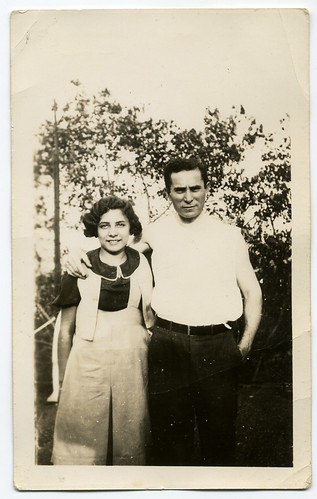Wednesday, March 30, 2011
Hilarious Annoying Music
I have been listening to WBEZ (NPR in Chicago) 's Jim Nader and the Annoying Music Podcast. Some of it really is too annoying, but here is some that is too funny not to share:
The only way to listen to Eminem:
I do like tacos:
And tonight's grande finale, Piranha Man:
Click here for more annoying music.
The only way to listen to Eminem:
I do like tacos:
And tonight's grande finale, Piranha Man:
Click here for more annoying music.
Snoopy On The African Queen
Kind of like Jungle Cruise, but the Boat is more accurate to The African Queen.
Labels: Adventurers Club, Animation, Disney, youtube
Friday, March 25, 2011
Did You Know: Rag Paper vs Wood Pulp Paper
Excerpted from http://www.cycleback.com/printsexamination/sixteen.html
Rag versus wood pulp.In the early history paper was made from rags.Starting about the mid 1800s, rag pulp began to be replaced by wood pulp.Wood became a popular choice due to the scarcity of rags and because wood pulp paper was cheaper to manufacture.The first successfully made American wood pulp paper was manufactured in Buffalo, New York, in 1855. By 1860, a large percentage of the total paper produced in the U.S. was still rag paper. Most of the newspapers printed in the U.S. during the Civil War period survived because they were essentially acid-free 100% rag paper, but the newspapers printed in the late 1880s turn brown because of the high acid content of the wood pulp paper. In 1882, the sulfite wood pulp process, that is still in use today, was developed on a commercial scale and most of the high acid content paper was used thereafter in newspapers, magazines and books.
Counterintuitively, modern paper, especially in books, letters and newspapers, is much more likely to turn brown and brittle than paper from before the American Civil War. For the beginning collector, the paper on an early 1800s print can be surprisingly fresh and white.
Labels: conservation, history, paper, photography, preservation
Thursday, March 17, 2011
Consering and Preserving Documents and Artifacts at the Imperial War Museum
All of these images are from the conservation lab at the Imperial War Museum
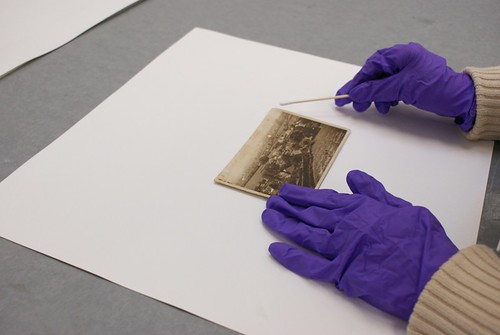
Cleaning a photo
To clean the surface of the photo, Tina carefully rolls (never rubs) a swab across it to pick up any dirt or dust.
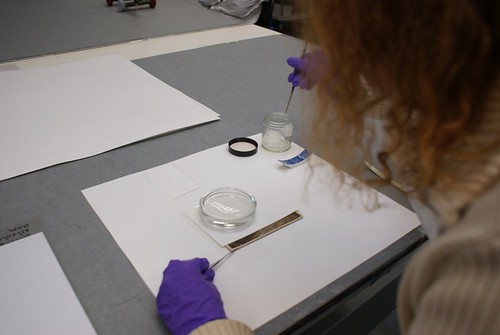
Repairing a photo
Any small rips or tears in the photographs are repaired using wheat starch paste
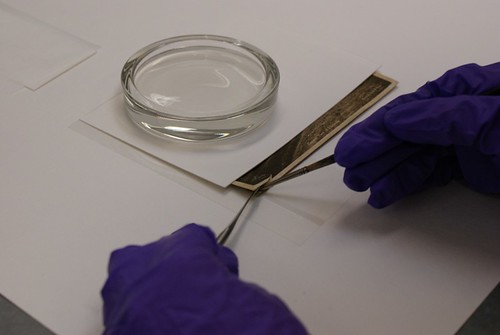
Repairing a photo step 2
The paste is applied to the card mount, not the underside of the photo surface, so that the card can absorb the excess moisture in the paste.
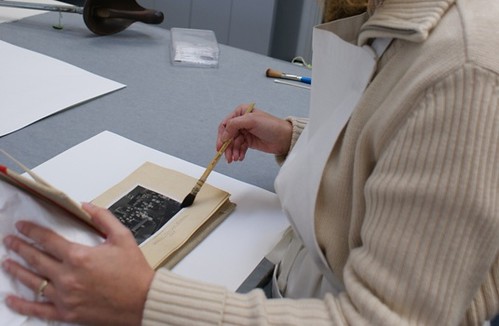
Photo consevation in action
Conservator Tina Kelly working on a photo album that will appear in the exhibition. The cushion is used to support the cover of the album when condition reporting. Without the cushion, which is actually more like a bean bag that can be squished the required shape, the spine could break.
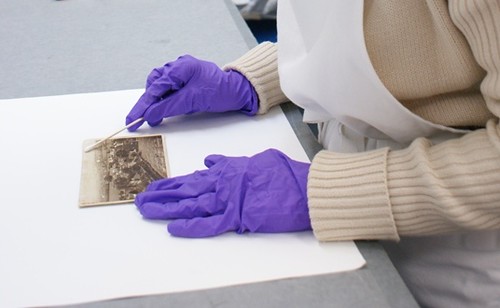
Get yer gloves on!
Gloves must be worn when handling photographs as fingerprints can damage the gelatine that forms the surface of the photo.
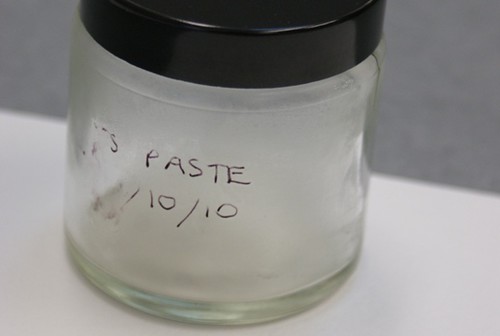
Wheat starch paste
Don't eat this in class...
------------
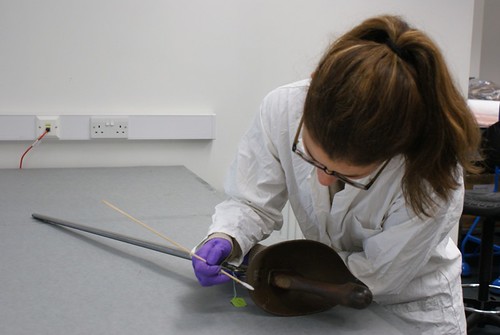
Sword cleaning
Conservator Heidrun Gassner cleans a British cavalry sword, dating from around 1908, with a solvent (acetone) to remove any grease.
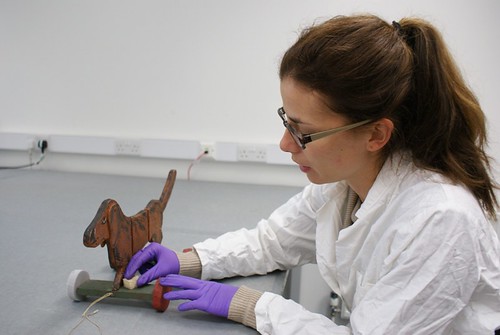
Sponge bath
However, acetone should not be used on painted surfaces. Instead, a sponge is used to clean off any surface dirt.
--------------

Tearing
Old paper is fragile and easily damaged, so any tears must be repaired before an item is handed over to the Exhibitions team for installation in a showcase.

Repairing
Tina Kelly is using wheat starch paste to attach Japanese Tengujo tissue to repair a small rip at the edge of this pamphlet. The tissue acts like sticky tape, preventing the tear from ripping further into the page.

Cleaning
When bringing the boiler out of storage, the Conservation team found that someone had covered the entire surface in sticky grease and wrapped it in greaseproof paper. Joanna Cook, above, has been hard at work with a bottle of acetone and a cotton swab, removing the grease and getting the boiler ready for display.

Museum Vac in action!
Looking after fabrics requires careful work. The scarf has to be carefully vacuumed using a special low suction ‘Museum Vac’ to remove dust and any remnants of old pest damage. Dust is particularly harmful to fabric - it can attract pests, can cause staining and can damage delicate fibres.

Cleaning a photo
To clean the surface of the photo, Tina carefully rolls (never rubs) a swab across it to pick up any dirt or dust.

Repairing a photo
Any small rips or tears in the photographs are repaired using wheat starch paste

Repairing a photo step 2
The paste is applied to the card mount, not the underside of the photo surface, so that the card can absorb the excess moisture in the paste.

Photo consevation in action
Conservator Tina Kelly working on a photo album that will appear in the exhibition. The cushion is used to support the cover of the album when condition reporting. Without the cushion, which is actually more like a bean bag that can be squished the required shape, the spine could break.

Get yer gloves on!
Gloves must be worn when handling photographs as fingerprints can damage the gelatine that forms the surface of the photo.

Wheat starch paste
Don't eat this in class...
------------

Sword cleaning
Conservator Heidrun Gassner cleans a British cavalry sword, dating from around 1908, with a solvent (acetone) to remove any grease.

Sponge bath
However, acetone should not be used on painted surfaces. Instead, a sponge is used to clean off any surface dirt.
--------------

Tearing
Old paper is fragile and easily damaged, so any tears must be repaired before an item is handed over to the Exhibitions team for installation in a showcase.

Repairing
Tina Kelly is using wheat starch paste to attach Japanese Tengujo tissue to repair a small rip at the edge of this pamphlet. The tissue acts like sticky tape, preventing the tear from ripping further into the page.

Cleaning
When bringing the boiler out of storage, the Conservation team found that someone had covered the entire surface in sticky grease and wrapped it in greaseproof paper. Joanna Cook, above, has been hard at work with a bottle of acetone and a cotton swab, removing the grease and getting the boiler ready for display.

Museum Vac in action!
Looking after fabrics requires careful work. The scarf has to be carefully vacuumed using a special low suction ‘Museum Vac’ to remove dust and any remnants of old pest damage. Dust is particularly harmful to fabric - it can attract pests, can cause staining and can damage delicate fibres.
Labels: conservation, environment, flickr, history, photography, pictures, preservation, tools
Monday, March 14, 2011
Lyrics: Steven Lutvak - The Dinner Party
I was at a dinner party just a couple of weeks ago
All the guests were chic and/or high powered
The repartee was brisk
Throughout the lobster bisque
And the salad course completely Noël Coward
But then the conversation took an unexpected turn
And headed frankly where, I thought, it needn't
As one by one each guest
Did his very level best
To talk about his favorite antecedent
As their relatives had been where mine had never been
This was a topic to which I could find no entry
They spoke of duchesses and lords
Barons by the hoards
Favorites of several kings who'd reaped their sweet rewards
Several from the Mayflower
Several who'd owned fjords
And we hadn't even hit the eighteenth century
But with a startling pâté
Which was lovely by the way
A most alarming hush fell on the table
My hostess smiled, "And you,
what did your family do?"
I gave the best reply which I was able
And which I swore was absolutely true
We were bagel makers to the Czar
The lineage goes back very very very far
I think Ivan was the one
Who when fed up with the bun
Sent his men in search of something starchy and bizarre
Who came upon my uncle who had recently solved the riddle
Of how to make a roll with a hole in the middle
He served them fresh to Ivan's commissar
And was thus named bagel maker to the Czar
We were bagel makers to the czar
In the land of sour cream and caviar
Later Olga it is said
Never even tasted bread
And her mother, the Tsarina
Would not get out of bed
Without a toasted onion with some unexpected spread
Which added to her middle
But did wonders for her head
Oh, the things you learn about which must remain unsaid
When you bagel maker to the czar
I realized in a flash that since I'd begun to speak
all earlier camaraderie was gone
There every jaw was slack
They were taken so aback
I really had no choice but to go on
We were bagel makers to the czar
Who would give us every year another samovar
And it was Catherine the Great
That over-zealous head of state
Who fed some to her horse
But that of course
For her was par
And little Anastasia could never get her fill
See there are those who say
That yet today
She's snacking on them still
But then that's taking things a little bit too far
For even bagel makers to the czar
Before the hammer and the sickle
We were there with pumpernickel
The things we did with poppy
Everyone unsuccessfully tried to copy
[Everybody]
We were bagel makers to the czar
[Oh, thank you, that was wonderful]
No one ever learned the secret of our scrumptious repertoire
But of course it couldn't last
For, like all empires of the past
Who reach their inevitable finales
For when the revolution came
We very slightly changed our name
Traveled North
And made a fortune in bialys
All the guests were chic and/or high powered
The repartee was brisk
Throughout the lobster bisque
And the salad course completely Noël Coward
But then the conversation took an unexpected turn
And headed frankly where, I thought, it needn't
As one by one each guest
Did his very level best
To talk about his favorite antecedent
As their relatives had been where mine had never been
This was a topic to which I could find no entry
They spoke of duchesses and lords
Barons by the hoards
Favorites of several kings who'd reaped their sweet rewards
Several from the Mayflower
Several who'd owned fjords
And we hadn't even hit the eighteenth century
But with a startling pâté
Which was lovely by the way
A most alarming hush fell on the table
My hostess smiled, "And you,
what did your family do?"
I gave the best reply which I was able
And which I swore was absolutely true
We were bagel makers to the Czar
The lineage goes back very very very far
I think Ivan was the one
Who when fed up with the bun
Sent his men in search of something starchy and bizarre
Who came upon my uncle who had recently solved the riddle
Of how to make a roll with a hole in the middle
He served them fresh to Ivan's commissar
And was thus named bagel maker to the Czar
We were bagel makers to the czar
In the land of sour cream and caviar
Later Olga it is said
Never even tasted bread
And her mother, the Tsarina
Would not get out of bed
Without a toasted onion with some unexpected spread
Which added to her middle
But did wonders for her head
Oh, the things you learn about which must remain unsaid
When you bagel maker to the czar
I realized in a flash that since I'd begun to speak
all earlier camaraderie was gone
There every jaw was slack
They were taken so aback
I really had no choice but to go on
We were bagel makers to the czar
Who would give us every year another samovar
And it was Catherine the Great
That over-zealous head of state
Who fed some to her horse
But that of course
For her was par
And little Anastasia could never get her fill
See there are those who say
That yet today
She's snacking on them still
But then that's taking things a little bit too far
For even bagel makers to the czar
Before the hammer and the sickle
We were there with pumpernickel
The things we did with poppy
Everyone unsuccessfully tried to copy
[Everybody]
We were bagel makers to the czar
[Oh, thank you, that was wonderful]
No one ever learned the secret of our scrumptious repertoire
But of course it couldn't last
For, like all empires of the past
Who reach their inevitable finales
For when the revolution came
We very slightly changed our name
Traveled North
And made a fortune in bialys
